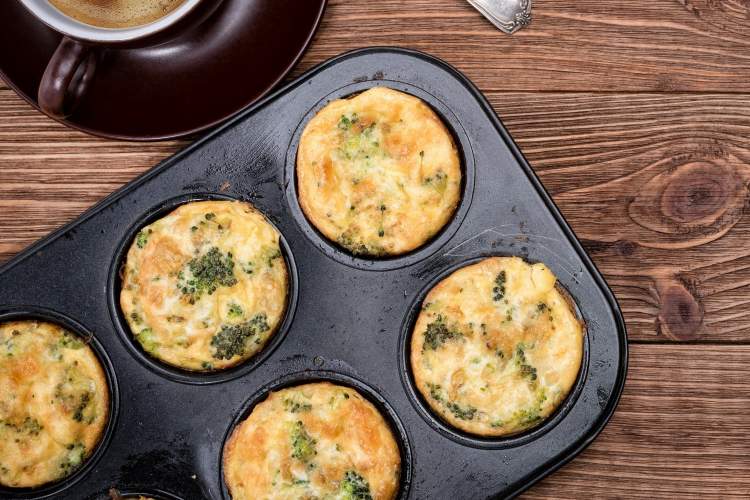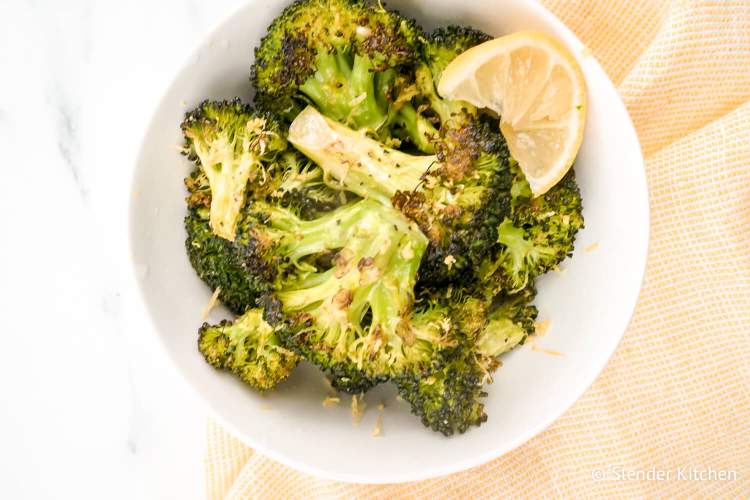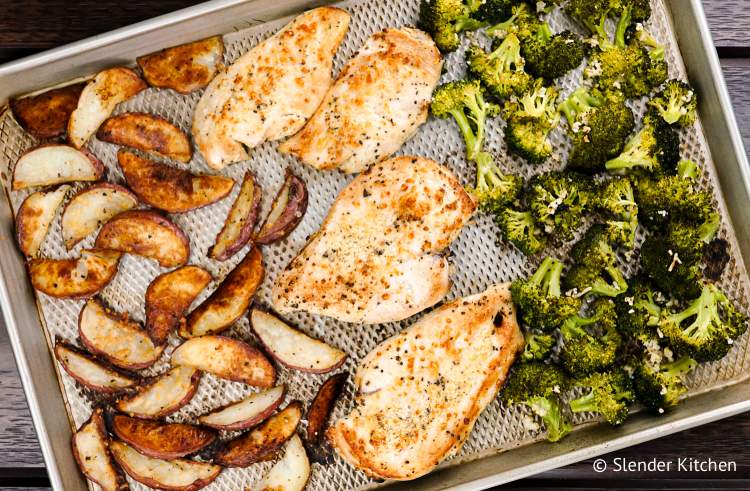Everything you have ever wanted to know about broccoli including its health benefits, how to cook it, recipe ideas, and more.
In this post, you will learn everything there is to know about the wonderful vegetable that is broccoli. Learn all about its nutritional benefits, and how to choose it, store it, and cook it.
Broccoli has to be one of my favorite vegetables. Even though, growing up, I didn’t like it that much (whether it was referred to as “tiny trees” or any other cutesy name). Maybe because it was mostly served kinda mushy or covered in cheese. Or maybe it was just one of those vegetables that you “had” to eat — like some kind of punishment. “Eat your broccoli or you can’t have dessert.” “If you feed your broccoli to the dog one more time, you’re grounded.” I’m sure we’ve all been threatened with a vegetable or two.
However, broccoli somehow became cool again, despite me…or maybe in spite of me. Broccoli is no longer passé, and for that, I’m actually grateful. Nothing beats the smoky, slightly bitter taste of grilled broccoli. Or the yummy way broccoli complements a pasta dish. Or how shredded broccoli works as a perfect stand-in for cabbage in slaw. Or the smell of broccoli roasting in your oven…I think you get the picture.
Interestingly enough, broccoli is actually a member of the cabbage family and can be either eaten raw or cooked. It really does resemble a small tree, with a thick stalk and flowering heads. In general, it tastes slightly bitter and earthy.
Kinds of Broccoli
The most common form of broccoli is the Calabrese Broccoli. There is also a kind called Sprouting Broccoli which has many heads and thin stalks. Broccoli can also be purple, though it’s referred to as Purple Cauliflower. And Broccoli Rabe isn’t broccoli at all, but a kind of turnip.
Confused yet? Me too. Let’s keep going. Broccolini is some sort of hybrid plant, created from regular, old fashioned broccoli and Chinese Broccoli. And while we’re at it, Chinese Broccoli looks like kale, and is mostly stalk and leaves with very little florets. Use whichever one you want, however you want. But keep in mind that some can taste more bitter than others.
For the purposes of this post, I’ll be discussing your run-of-the-mill, Calabrese Broccoli that you can find at practically any grocery store or produce market. If you’re looking for an inexpensive, filling, nutritious vegetable that goes with almost anything, then look no further than this tried-and-true favorite.

Is Broccoli Good for You?
If you’re trying to think of a vegetable that checks all the boxes — tastes good, incorporates well into most recipes, is low-calorie, high in fiber and packed full of important vitamins, minerals, and other nutrients, then you’d be hard pressed to find something better than broccoli.
Broccoli has more vitamin C than an orange (!) and is a great source of beta-carotene (much like carrots). Inside all those lovely florets and stems it also has a bunch of B vitamins, potassium, zinc, and iron. Broccoli is a great food to add to your diet if you’re trying to lose or maintain your weight as well because it is low in calories and full of fiber.
The Nutritional Makeup of Broccoli
One cup of chopped broccoli contains 31 calories, 2.5 gram of protein, less than one gram of fat, 6 grams of carbs, 3 grams of fiber, and less than 2 grams of sugar. In addition, you’ll find calcium (almost as much as a serving of dairy), iron, zinc, riboflavin, folate, vitamin E, K, and zero cholesterol!
The Health Benefits of Eating Broccoli
- Broccoli fills you up. Those three grams of fiber you get in every serving of broccoli can help keep you feeling fuller, longer and can act as an appetite suppressant. Fiber is also great for keeping your digestive tract healthy and can help you manage your weight. Most people need between 25 to 30 grams of fiber a day, but don’t quite get it all in. Add cooked broccoli to a pasta dish, as a side, or serve raw as a snack with a side of hummus. Have two cups at a time if you want, to ensure you’re fulfilling all your fiber needs.
- It makes your bones strong. The 43 mg of calcium found in every cup of broccoli contains nearly the same amount half a cup of cottage cheese. Calcium is important for not only keeping your bones and teeth strong, but it also helps your blot clot, your nerves to signal, regulates your heart rate, and helps your body release important hormones. If you’re looking for a great way to get your calcium without the fat, then broccoli is a great choice. If you are lactose intolerant or vegetarian or vegan, making sure you have enough calcium is important and broccoli can definitely help fulfill that need.
- Broccoli is a great diet food. Because broccoli is low in calories, this is one of those foods (like many, but not all, veggies) that you can eat a lot of and not feel bad about. There’s only 31 calories in one cup of chopped broccoli, so I say go ahead and have two or three servings. Sometimes I add steamed broccoli to my pasta to “cut” the noodles and make it more nutritious. Occasionally (although I love them), I don’t want to mess with the zoodles, I’m sure you feel me on that. A nice tomato-based pasta sauce is delish on broccoli. I promise.
- It has the C. Vitamin C that is, and lots of it. One serving of broccoli contains 81 mg of vitamin C. That’s a whole lot if you ask me. One orange only has 51 mg. Vitamin C is a powerful antioxidant. It’s crucial in the defense of colds and illnesses and helps to protect you against immune system deficiencies. It also staves off cardiovascular disease, eye disease, skin wrinkling, and possible prenatal health problems.
- Broccoli is good for your heart. Broccoli contains sulforaphane, which acts as an anti-inflammatory. Sulforaphane has also been shown to prevent or reverse damage done to blood vessel linings that is caused by blood sugar issues. The vitamin B found in broccoli can reduce or regulate excessive amino acids your body might have if you eat too much red meat. Eating too much red meat can increase your risk of coronary artery disease.
- It’s low in fat. Broccoli is nearly fat-free (we’re talking almost zero). That means you have plenty of room left in your diet for other healthy fats, like the ones you’ll get from avocados, eggs, salmon, and olive oil.
- It can help lower your blood pressure. Did you know that adequate consumption of potassium is essential for maintaining your blood pressure? The potassium found in fruits and veggies such as broccoli helps your kidneys to work more efficiently, thus balancing out the sodium levels in your body to stabilize your blood pressure.

Is Broccoli Really a Superfood?
I’m going to get all definition-y on you here. According to Dictionary.com, a “Superfood” is, “A food considered exceptionally good for one’s health and for boosting the immune system owing to its naturally high content of vitamins, minerals, fiber, antioxidants, or omega-3 fatty acids.”
Now that that’s out of the way, I would say that yes, broccoli would fall under the category of “superfood,” wouldn’t you?
Can You Eat Raw Broccoli?
You most certainly can eat broccoli raw. It depends on your preference. Personally, if I’m going to eat it raw, I like to eat it cut up with other veggies and some low-cal dip. Some studies suggest that eating broccoli raw (or steamed) is the best way to eat it. This is because the cooking process can break down or make unavailable some compounds and nutrients that raw broccoli contains.
It will not make you sick to eat raw broccoli. That is, of course, unless you eat too much broccoli and then you might find yourself on fiber overload and running to the bathroom quite often. As I always say, moderation, moderation, moderation. Plus, who wants to eat only one thing? Broccoli is great, but so are lots of other vegetables. Mix it up!
Which Part of Broccoli Is the Best for You?
Broccoli is broccoli is broccoli. The stem and the florets are equally as good for you. The nutrients running through broccoli are nearly identical, whether you eat the tippy top or the very end. However, florets will have slightly more vitamin A, though not enough to justify only eating the florets for that reason. If you don’t like the stems, just say so. 🙂
However, when I cut up broccoli, I do remove the florets, then cut off the harder outside skin of the broccoli before cooking or eating it. I find that eating the stem isn’t a big deal once the harder parts are removed. It will cook up quite nicely and be softer than if you left the outside on. But it really doesn’t matter. Any way you slice it, it is edible, nutritious, and delicious.
How to Choose Broccoli
When choosing broccoli, you want to look for a nice green color and no woodiness to the stem. When you pick it up, it should feel heavy for its size. You’ll want the florets to be closed and tightly packed together and you’ll want to avoid any broccoli heads that have any yellowing florets, wilty leaves, or brown spots.
How to Store Broccoli
You should keep broccoli dry and in your veggie drawer. Do not wash it until it’s ready to be eaten. You can keep it in the plastic bag it came in but leave the bag open. If purchased fresh and stored correctly, the broccoli can keep for up to 10 days.
If you’ve purchased pre-cut broccoli or want to cut the broccoli ahead of time for easy snacking, pat it dry after rinsing and store it in a loose container or bag and eat it within one to two days.
Preparing Broccoli for Cooking
When you’re ready to eat the broccoli or cook with it, first rinse it off, then cut the florets from the stem or stalk. Then, either trim the exterior of the stems off and cut the inner pieces of stem or discard the stalks.

How to Cook With Broccoli
Roasted Broccoli Recipes
Parmesan Roasted Broccoli is a favorite around this house. Parmesan cheese really brings out the already nutty flavor of the broccoli. Roasting broccoli brings out a different taste from straight-up steaming, one that many prefer. Even if someone thinks they don’t like broccoli, they’re going to love this recipe. For a basic roasted broccoli recipe, try this Crispy Baked Broccoli or switch things up with this Sesame Soy Broccoli.
Grilled Broccoli Recipes
I could make this Garlic Grilled Broccoli two or three times a week, easy. When you let the broccoli get slightly charred (which I recommend), it develops a sweeter, nuttier flavor than when it’s made with other preparations. When grilling broccoli, you wash and cut your broccoli as stated above, and then toss it in olive oil and a spice combination (in this case, garlic). To keep your broccoli from sticking, put foil down on top of the grates first (or use a grill basket). Grill broccoli over medium heat, turning once or twice.
Recipes for Raw Broccoli
Using raw broccoli works well in a couple of ways. One way is to simply prepare it for a veggie tray with dip. The other way is to add it to a salad. If you’re going to go the salad route, I recommend cutting your broccoli into small, bite-size pieces (or you can sometimes find pre-packaged, shredded broccoli slaw at the grocery store). This Skinny Broccoli Salad contains everything you love about healthy eating and none of the heavy, fatty dressings. Sesame Ginger Broccoli Slaw makes use of the shredded broccoli slaw in a oh-so-tasty way. Or, for something entirely unexpected, bring this Curried Broccoli Salad to your next potluck.
Main Dishes with Broccoli
Broccoli is easy to add to almost any dish — pasta, rice, or stir-fries, with chicken, beef, tofu, or in a vegetarian dish. My favorite preparations for adding broccoli to a main meal include this Creamy Chicken and Broccoli Pasta, Broccoli Cheddar Egg Muffins, Beef and Broccoli Fried Rice, and (one of my personal favorites) Lemon Orzo with Broccoli and Chicken Sausage. You also may love this Sesame Tofu and Broccoli, Lemon Broccoli Pasta with Shrimp, or Healthy Broccoli Cheddar Soup.
Source link